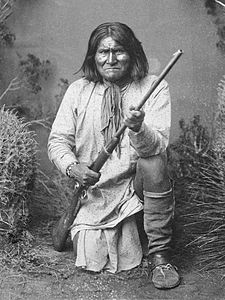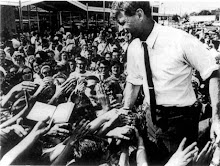Geronimo
From Wikipedia, the free encyclopedia
| Geronimo | |
 | |
| Born | Goyathlay, Goyaałé: "one who yawns" June 16, 1829 Gila River, Mexico |
|---|---|
| Died | February 17, 1909 (aged 79) Fort Sill, Oklahoma |
| Occupation | Medicine man |
| Known for | A famous Apache Warrior |
Geronimo (Chiricahua: Goyaałé, "one who yawns"; often spelled Goyathlay or Goyahkla[1] in English) (June 16, 1829–February 17, 1909) was a prominent Native American leader of the Chiricahua Apache who defended his people against the encroachment of the United States on their tribal lands for over 25 years.
Biography
Goyaałé (Geronimo) was born to the Bedonkohe band of the Apache, near Turkey Creek, a tributary of the Gila River in the modern-day state of Arizona, then part of Mexico, but which his family considered Bedonkohe land.
Geronimo's father, Tablishim, and mother, Juana, educated him according to Apache traditions. He married a woman from the Chiricauhua band of Apache; they had three children. On March 5, 1851, a company of 400 soldiers from Sonora led by Colonel Jose Maria Carrasco attacked Geronimo's camp outside Janos while the men were in town trading. Among those dead were Geronimo's wife, Alope, his children, and mother. His chief, Mangas Coloradas, sent him to Cochise's band for help in revenge against the Mexicans. It was the Mexicans who named him Geronimo. This appellation stemmed from a battle in which he repeatedly attacked Mexican soldiers with a knife, ignoring a deadly hail of bullets, in reference to the Mexicans' plea to Saint Jerome. The name stuck.[1]
The first Apache raids on Sonora appear to have taken place during the late 17th century. To counter the early Apache raids on Spanish settlements, presidios were established at Janos (1685) in Chihuahua and at Fronteras (1690) in northern Opata country. In 1835, Mexico had placed a bounty on Apache scalps. Two years later Mangas Coloradas or Dasoda-hae (Red Sleeves) became principal chief and war leader and began a series of retaliatory raids against the Mexicans. Apache raids on Mexican villages were so numerous and brutal that no area was safe.[2]
While Geronimo said he was never a chief, he was a military leader. As a Chiricahua Apache, this meant he was also a spiritual leader. He consistently urged raids and war upon many Mexican and later U.S. groups.
He married Chee-hash-kish and had two children, Chappo and Dohn-say. Then he took another wife, Nana-tha-thtith, with whom he had one child. He later had a wife named Zi-yeh at the same time as another wife, She-gha, one named Shtsha-she and later a wife named Ih-tedda. Some of his wives were captured, such as the young Ih-tedda. Wives came and went, overlapping each other, being captured and added to the family, lost, or even given up, as Geronimo did with Ih-tedda when he and his band surrendered. At that time he kept his wife She-gha but abandoned the younger wife, Ih-tedda. Geronimo’s last wife was Azul.
Though outnumbered, Geronimo fought against both Mexican and United States troops and became famous for his daring exploits and numerous escapes from capture from 1858 to 1886. One such escape, as legend has it, took place in the Robledo Mountains of southwest New Mexico. The legend states Geronimo and his followers entered a Cave, and the U.S. Soldiers waited outside the cave entrance for him, but he never came out. Later it was heard that Geronimo was spotted in a nearby area. The second entrance to the cave has yet to be found and the cave is still called Geronimo's Cave. At the end of his military career, he led a small band of 38 men, women, and children. They evaded 5,000 U.S. troops (one fourth of the army at the time) and many units of the Mexican army for a year. His band was one of the last major forces of independent Indian warriors who refused to acknowledge the United States Government in the American West. This came to an end on September 4, 1886, when Geronimo surrendered to United States Army General Nelson A. Miles at Skeleton Canyon, Arizona.
Geronimo and other warriors were sent as prisoners to Fort Pickens, Florida, and his family was sent to Fort Marion. They were reunited in May 1887, when they were transferred to Mount Vernon Barracks in Alabama for five years. In 1894, they were moved to Fort Sill, Oklahoma. In his old age, Geronimo became a celebrity. He appeared at fairs, including the 1904 World's Fair in St. Louis, and sold souvenirs and photographs of himself. However, he was not allowed to return to the land of his birth. He rode in President Theodore Roosevelt's 1905 inaugural parade. He died of pneumonia at Fort Sill,Oklahoma in 1909 and was buried at the Apache Indian Prisoner of War Cemetery there.
In 1905, Geronimo agreed to tell his story to S.M. Barrett, Superintendent of Education in Lawton, Oklahoma. Barrett had to appeal to President Roosevelt to gain permission to publish the book. Geronimo came to each interview knowing exactly what he wanted to say. He refused to answer questions or alter his narrative. Barrett did not seem to take many liberties with Geronimo's story as translated by Asa Daklugie. Frederick Turner re-edited this autobiography by removing some of Barrett's footnotes and writing an introduction for the non-Apache readers. Turner notes the book is in the style of an Apache reciting part of his oral history.[3]
Religion
Geronimo was raised with the traditional religious views of the Bedonkohe. When questioned about his views on life after death, he wrote in his 1905 autobiography, "As to the future state, the teachings of our tribe were not specific, that is, we had no definite idea of our relations and surroundings in after life. We believed that there is a life after this one, but no one ever told me as to what part of man lived after death...We held that the discharge of one's duty would make his future life more pleasant, but whether that future life was worse than this life or better, we did not know, and no one was able to tell us. We hoped that in the future life family and tribal relations would be resumed. In a way we believed this, but we did not know it." [4]
Later in life, Geronimo embraced Christianity, and stated, "Since my life as a prisoner has begun I have heard the teachings of the white man's religion, and in many respects believe it to be better than the religion of my fathers...Believing that in a wise way it is good to go to church, and that associating with Christians would improve my character, I have adopted the Christian religion. I believe that the church has helped me much during the short time I have been a member. I am not ashamed to be a Christian, and I am glad to know that the President of the United States is a Christian, for without the help of the Almighty I do not think he could rightly judge in ruling so many people. I have advised all of my people who are not Christians, to study that religion, because it seems to me the best religion in enabling one to live right." [5]He joined the Dutch Reformed Church in 1903 but four years later was expelled for gambling.[6] To the end of his life, he seemed to harbor ambivalent religious feelings, telling the Christian missionaries at a summer camp meeting in 1908 that he wanted to start over, while at the same time telling his tribesmen that he held to the old Apache religion.[7]
Theft of remains
In 1918, certain remains of Geronimo were stolen in a grave robbery. Three members of the Yale secret society of Skull and Bones served as Army volunteers at Fort Sill during World War I; one of those three members was Prescott Bush, father of the forty-first President of the United States George H. W. Bush and grandfather of George W. Bush. They reportedly stole Geronimo's skull, some bones, and other items, including Geronimo's prized silver bridle, from the Apache Indian Prisoner of War Cemetery. The stolen items were alleged to have been taken to the society's tomb-like headquarters on the Yale University campus, and are supposedly used in rituals practiced by the group, one of which is said to be kissing the skull of Geronimo as an initiation. The story was known for many years but widely considered unlikely or apocryphal, and while the society itself remained silent, former members have said that they believed the bones were fake or non-human, possibly in an attempt at misdirection.[original research?]
In a contemporary letter discovered by the Yale historian Marc Wortman and published in the Yale Alumni Magazine in 2006, society member Winter Mead wrote to F. Trubee Davison:
- The skull of the worthy Geronimo the Terrible, exhumed from its tomb at Fort Sill by your club... is now safe inside the tomb ("tomb" is the building at Yale University's Skull and Bones) and bone together with his well worn femurs, bit and saddle horn.[8]
This prompted the Indian chief's great-grandson, Harlyn Geronimo of Mescalero, New Mexico, to write to President Bush requesting his help in returning the remains:
- According to our traditions the remains of this sort, especially in this state when the grave was desecrated ... need to be reburied with the proper rituals ... to return the dignity and let his spirits rest in peace.[9]







No comments:
Post a Comment